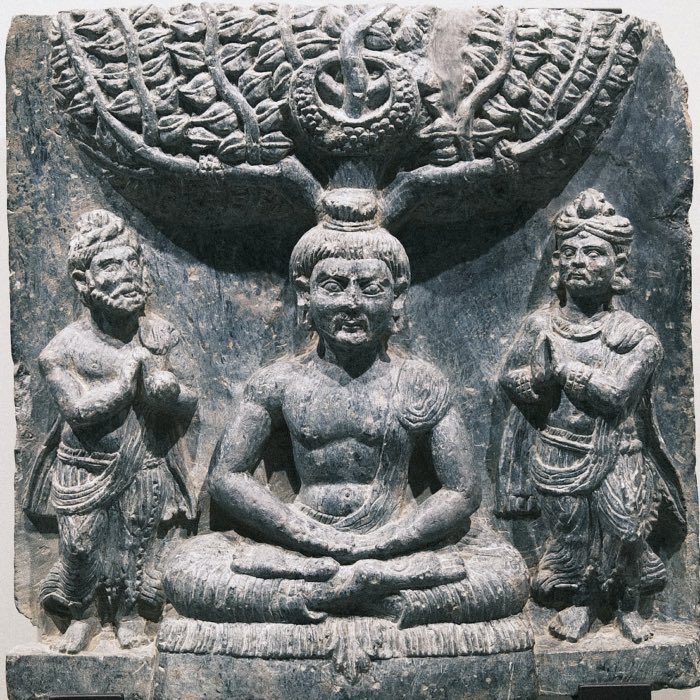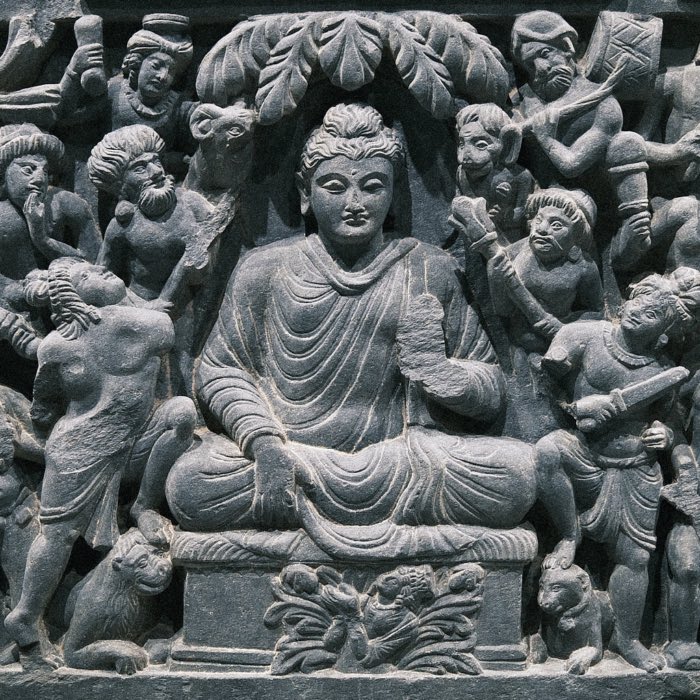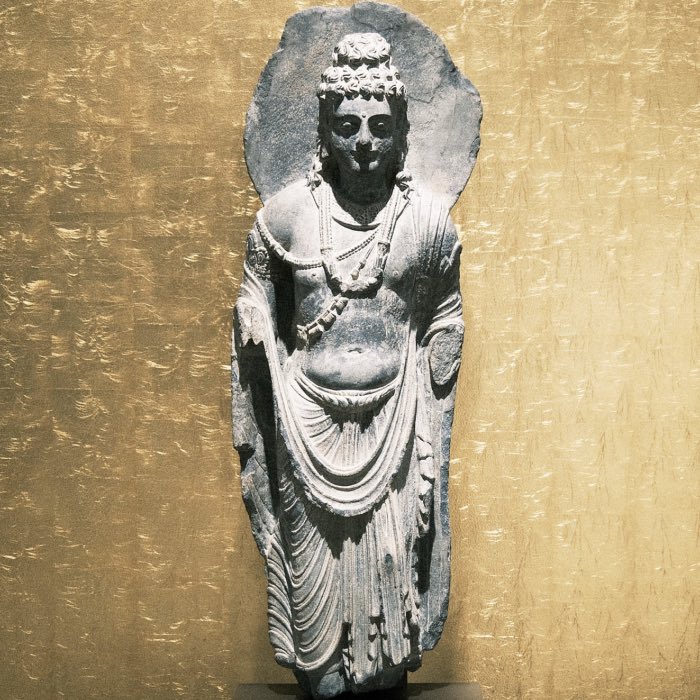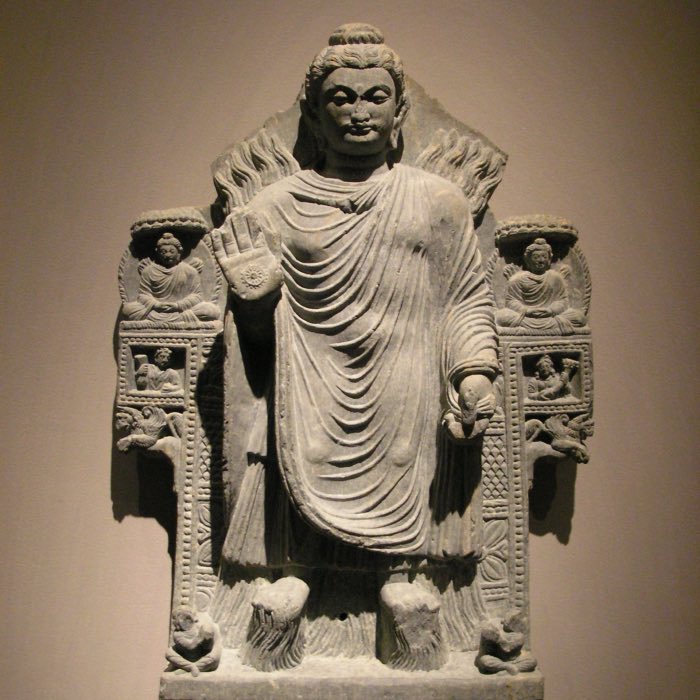The Awakening of Faith in the Mahāyāna: Unifying mind and suchness
The Awakening of Faith in the Mahāyāna is a foundational text in East Asian Buddhism, renowned for its profound synthesis of Indian Mahāyāna doctrines and Chinese philosophical concerns. Traditionally attributed to Aśvaghoṣa but now widely regarded as a 6th-century Chinese composition, the text played a crucial role in shaping the doctrinal landscape of Chinese, Korean, and Japanese Buddhism. By articulating the concept of the “One Mind” with its dual aspects of suchness and arising-and-ceasing, it offers a powerful framework for reconciling emptiness, Buddha-nature, and the process of awakening. In this article, we explore the origins, core teachings, and far-reaching influence of The Awakening of Faith, highlighting its significance as a bridge between philosophy and practice in the Mahāyāna tradition.

Commentary on the Mahayana sraddhotpada Sastra (Awakening of Faith in the Mahayana). Source: Wikimedia Commonsꜛ (license: CC BY-SA 4.0)
Introduction
The Awakening of Faith in the Mahāyāna is one of the most influential texts in the intellectual history of East Asian Buddhism. Traditionally attributed to the Indian thinker Aśvaghoṣa, modern scholarship now generally considers it a Chinese composition dating from the 6th century CE. Regardless of its exact origin, the text played a central role in shaping the doctrinal landscape of Chinese, Korean, and Japanese Mahāyāna traditions.
Its significance lies in its ambitious attempt to synthesize Indian Buddhist concepts — such as śūnyatā (emptiness), tathāgatagarbha (Buddha-nature), and Yogācāra thought — with the needs of East Asian metaphysical reflection. In doing so, it provided a framework for reconciling seemingly contradictory teachings: the unchanging nature of ultimate reality (tathatā, or suchness) and the dynamic, deluded processes of the conditioned world. Rather than treating these as metaphysical opposites, the text introduces a model of the “One Mind” with two aspects — suchness and arising-and-ceasing — which are not ultimately separate but dynamically related.
This doctrinal framework became foundational for several East Asian Buddhist schools, including Tiantai, Huayan, and Chán/Zen. It offered a metaphysical and psychological language through which practitioners could understand their own mind as both the ground of ignorance and the basis of liberation. The enduring appeal of The Awakening of Faith lies in its elegant resolution of dualisms that troubled both philosophers and meditators, presenting a unified view of reality that is both intellectually coherent and soteriologically powerful.
Textual origins and historical influence
Traditionally, The Awakening of Faith in the Mahāyāna (Dàshèng qǐxìn lùn 大乘起信論 in Chinese; Daijō kishin ron in Japanese was attributed to the Indian philosopher-poet Aśvaghoṣa, known for works such as the Buddhacarita. However, linguistic, doctrinal, and stylistic analyses have led most modern scholars to regard it as a Chinese composition, likely produced in the 6th century CE. The text shows deep familiarity with Indian Mahāyāna philosophy, particularly Yogācāra and tathāgatagarbha doctrines, but also exhibits conceptual structures and terminology consistent with indigenous Chinese thought. Its synthesis of Indian and Chinese elements suggests it was authored by a scholar-monk in China, possibly as a response to the interpretive challenges posed by the influx of complex Indian texts and doctrines.
At the time of its composition, Chinese Buddhism was grappling with a growing body of translated scriptures from India, which often presented diverse and seemingly contradictory doctrines. There was a pressing need to systematize and harmonize these teachings into a coherent worldview. The Awakening of Faith addressed this need by offering a unified theory of mind and reality that reconciled the dynamic world of phenomena with the unchanging truth of suchness. This framework allowed Chinese Buddhists to integrate core Mahāyāna doctrines into a native conceptual language that could guide both practice and philosophy.
The influence of the text was immediate and lasting. It was widely read and commented upon in China, where it became central to the doctrinal development of the Tiantai and Huayan schools. In Korea, the text gained special prominence through the work of the monk Wonhyo, who wrote a famous and influential commentary that helped establish it as a cornerstone of Korean Seon thought. In Japan, it was integrated into the Tendai curriculum and informed later developments in Pure Land and Zen traditions. The text’s articulation of inherent enlightenment, the non-duality of mind and reality, and the possibility of awakening as a return to one’s original nature resonated with East Asian metaphysical concerns and soteriological aspirations. It shaped not only doctrinal frameworks but also pedagogical methods and ritual practices, making it one of the most impactful texts in the East Asian Buddhist canon.
Core teaching: The One Mind and its two aspects
In The Awakening of Faith, the central teaching revolves around the concept of the “One Mind” (yi xin 一心), which serves as a unifying principle for understanding the nature of reality and the process of awakening. This One Mind is described as having two aspects: suchness (tathatā), representing the ultimate, unchanging nature of reality, and arising-and-ceasing (samsāra), which refers to the dynamic, conditioned world of appearances and deluded consciousness. These two aspects are not separate entities but are different expressions or perspectives of the same underlying mind.
The non-dual structure of mind
At the heart of The Awakening of Faith is the doctrine of the “One Mind” (yi xin 一心), a concept that seeks to overcome the dualistic tendencies often found in philosophical and religious thinking. The text describes this One Mind as having two aspects: suchness (tathatā), which represents the true, unchanging nature of reality, and arising-and-ceasing (samsāra), which refers to the dynamic, conditioned world of appearances and deluded consciousness. These two aspects are not separate entities but are different expressions or perspectives of the same underlying mind.
Suchness is described as the mind’s pure nature, untainted by conceptual elaboration or karmic conditioning. It is the ever-present, unchanging ground of being, synonymous with Buddha-nature and understood as identical with ultimate truth. In contrast, the arising-and-ceasing aspect accounts for the mind’s activity when it becomes obscured by ignorance and delusion. It reflects the conditioned process of samsaric existence: thoughts arise, objects appear, and suffering ensues — not because suchness has changed, but because the mind misperceives its own nature.
This non-dual view avoids the metaphysical pitfalls of positing an eternal substance or a nihilistic void. Instead, it frames delusion and awakening as modes of perception within a single continuum. The same mind that generates confusion is the one that, when properly understood, reveals awakening. Thus, the One Mind is simultaneously the source of delusion and the ground of liberation. This insight forms the philosophical foundation for later developments in East Asian Buddhism, especially in Chán/Zen, which emphasize the immediacy of awakening within ordinary consciousness.
Dynamic ignorance and awakening
The Awakening of Faith presents ignorance (avidyā) not as a fixed metaphysical force but as a dynamic, contingent misperception that arises within the activity of mind itself. This marks a subtle but crucial departure from more dualistic models that position ignorance as something externally imposed or fundamentally opposed to awakening. Instead, the text maintains that ignorance originates from the mind’s failure to recognize its own true nature, a process it calls “non-enlightenment” (buddhi-avidyā).
This non-enlightenment is not an inherent flaw or a cosmic principle but the result of a gradual distortion in the mind’s awareness. When the One Mind becomes obscured by discriminatory thinking — dividing self from other, existence from non-existence — it generates the dualistic framework in which delusion and suffering arise. Importantly, the underlying suchness of mind remains untouched throughout this process. The error lies not in the substance of mind but in the mode of perception.
Awakening, then, is not the acquisition of a new state or the arrival at a previously inaccessible truth. It is a re-cognition: a return to what was always already present. This “returning” is not spatial or temporal but cognitive and existential — the clearing away of false views and conceptual overlays to allow the inherent clarity of mind to manifest. In this model, practice becomes less about attaining something and more about unveiling what has been obscured. The possibility of awakening is ever-imminent because the nature of mind has never departed from suchness, even in the depths of delusion.
Reconciliation of emptiness and Buddha-nature
One of the philosophical accomplishments of The Awakening of Faith lies in its successful synthesis of two influential Mahāyāna doctrines that have often been seen as standing in tension: śūnyatā (emptiness) and tathāgatagarbha (Buddha-nature). While the former emphasizes the absence of inherent existence in all phenomena, the latter highlights the innate potential for awakening within all beings. Without careful handling, these two views could easily slide into either nihilism or essentialism. The text avoids both extremes by framing Buddha-nature not as an unchanging self or metaphysical substance, but as the mind’s intrinsic openness — empty of fixed identity and yet fully capable of realization.
In this view, tathāgatagarbha is not something added to or separate from the individual; it is the ever-present suchness of mind that becomes obscured by delusion. This is entirely compatible with the logic of śūnyatā, which denies fixed essences but does not deny continuity or potential. By describing Buddha-nature in terms that align with the emptiness of all dharmas, The Awakening of Faith offers a model of mind that is both empty in nature and luminous in function.
To express this delicate integration, the text makes use of evocative metaphors. One of the most well-known is that of the mirror and the dust: just as a mirror remains clear beneath a layer of dust, the true nature of mind remains unstained beneath delusive thoughts. Another is the metaphor of ocean and waves: suchness is the calm, undisturbed ocean, while arising-and-ceasing phenomena are the waves generated by wind. The waves may seem to obscure the ocean, but they are never separate from it. These images emphasize that awakening is not a transformation into something new, but the recognition of what has always been the case — emptiness and Buddha-nature as two aspects of the same underlying reality.
Practice and trust in awakening
In The Awakening of Faith, the concept of practice is grounded in a profound trust in the potential of mind itself. The text frames śraddhā, often translated as faith, not as blind belief or external devotion, but as a dynamic confidence in the path and in the mind’s capacity to awaken. This faith arises from a deep intuitive recognition that the true nature of reality — suchness — is not separate from one’s own awareness. Because delusion and awakening occur within the same mind, liberation is always possible.
Practice, in this view, is not aimed at creating enlightenment from scratch but at revealing what is already latent. The text emphasizes the importance of letting go of conceptual elaborations, attachments, and dualistic thinking. Meditation, ethical conduct, and reflection are presented as means of gradually dissolving the mental obscurations that prevent suchness from being directly perceived. This process-based model of mind (also see vinjanas) situates transformation not in external rituals or metaphysical interventions, but in the continuous refinement of perception and conduct.
Integral to this path is the Bodhisattva ideal. The practitioner does not seek liberation for oneself alone, but embodies compassion (karuṇā) and acts for the benefit of all beings. Because all beings share the same One Mind and possess the same capacity for awakening, the Bodhisattva’s conduct is both a form of practice and an expression of wisdom. The cultivation of compassion is not an additional practice layered onto insight; it arises naturally from the recognition of interdependence and the absence of self. Thus, trust in awakening, disciplined practice, and compassionate engagement form an inseparable triad in the text’s vision of the Buddhist path.
Influence on later East Asian thought
The Awakening of Faith exerted a profound influence on the doctrinal formation and contemplative frameworks of several major East Asian Buddhist schools. Its concept of the One Mind with two aspects provided a powerful conceptual tool for reconciling emptiness and form, delusion and awakening — an insight that was taken up and further systematized by the Tiantai school. Tiantai’s doctrine of the “threefold truth” — emptiness, conventional existence, and the middle — can be seen as an expansion of the text’s effort to unify ultimate and conditioned realities. Similarly, the school’s meditative approach of “fourfold samādhi” was shaped in part by the vision of integrated practice articulated in The Awakening of Faith.
In the Huayan tradition, the text’s emphasis on the non-dual nature of reality and the inseparability of suchness and phenomena resonated strongly with its doctrine of interpenetration (dharmadhātu pratītyasamutpāda). Huayan thinkers like Fazang found in the Awakening of Faith a philosophical ally for explaining how all things mutually contain one another without losing their distinctness — an insight that the text’s metaphors of mirror and dust, or waves and ocean, vividly support.
Chán and Zen Buddhism, particularly in its emphasis on sudden awakening and original mind, also drew heavily on this text’s core insights. The idea that enlightenment is not something to be attained but something to be recognized as already present echoes throughout Zen teachings. The Awakening of Faith helped furnish the theoretical grounding for such views, framing the path as a matter of returning to the mind’s original clarity rather than acquiring a new state. Its legacy thus extends across traditions, providing a philosophical and soteriological foundation for key aspects of East Asian Buddhist thought and practice.
Conclusion
The Awakening of Faith in the Mahāyāna stands as a pivotal text in the transmission and transformation of Mahāyāna Buddhist thought from its Indian roots into a distinctly East Asian philosophical and soteriological framework. Its elegant articulation of the One Mind with two aspects allowed for a nuanced reconciliation of key doctrines such as emptiness and Buddha-nature, affirming the possibility of awakening without positing an unchanging metaphysical self.
By offering a model of mind that is at once dynamic and non-dual, the text laid the foundation for later developments in Chinese Tiantai and Huayan thought, Korean Seon, and Japanese Tendai and Zen. Its influence can be seen not only in formal doctrine but also in the emphasis on sudden awakening, original mind, and non-conceptual realization that came to define much of East Asian Buddhist practice.
For readers today, the text offers a powerful conceptual and practical resource for understanding how delusion and awakening, emptiness and compassion, are not separate domains but interwoven expressions of the same mind. Its enduring relevance lies in its capacity to bridge abstract philosophy with lived experience, inviting a return to the ever-present ground of awareness that remains unstained even in the midst of confusion.
References and further reading
- Oliver Freiberger, Christoph Kleine, Buddhismus - Handbuch und kritische Einführung, 2011, Vandenhoeck & Ruprecht, ISBN: 9783525500040
- Rupert Gethin, The Foundations Of Buddhism, 1998, Oxford University Press, ISBN: 9780192892232
- Oliver Bottini, Das grosse O.W. Barth-Buch des Buddhismus, 2004, Ebner & Spiegel GmbH, ISBN: 9783502611264
- Jr. Buswell, Robert E., Jr. Lopez, Donald S., Juhn Ahn, J. Wayne Bass, William Chu, The Princeton dictionary of Buddhism, 2014, Princeton University Press, ISBN: 978-0-691-15786-3
- Oliver Bottini, Das große O.-W.-Barth-Buch des Zen, 2002, Barth im Scherz-Verl, ISBN: 9783502611042
- Hans-Günter Wagner, Buddhismus in China: Von den Anfängen bis in die Gegenwart, 2020, Matthes & Seitz Berlin, ISBN: 978-3957578440
- Heinrich Dumoulin, Geschichte des Zen-Buddhismus, Band 1+2, 2019, 2., durchgesehene und erweiterte Auflage, Francke A. Verlag, ISBN: 9783772085161








































comments